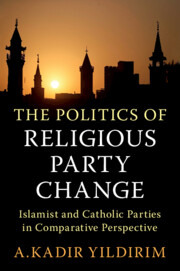Book contents
- The Politics of Religious Party Change
- Cambridge Studies in Social Theory, Religion, and Politics
- The Politics of Religious Party Change
- Copyright page
- Contents
- List of Figures
- List of Tables
- Acknowledgments
- Introduction
- 1 Explaining Religious Party Change
- 2 Catholic and Islamic Religious Institutions
- 3 Anticlericalism, Religious Revival, and the Rise of Religious Political Identities
- 4 The Origins of Religiopolitical Identity
- 5 Intraparty Conflict
- Conclusion
- Bibliography
- List of Interviews
- Index
3 - Anticlericalism, Religious Revival, and the Rise of Religious Political Identities
Published online by Cambridge University Press: 22 December 2022
- The Politics of Religious Party Change
- Cambridge Studies in Social Theory, Religion, and Politics
- The Politics of Religious Party Change
- Copyright page
- Contents
- List of Figures
- List of Tables
- Acknowledgments
- Introduction
- 1 Explaining Religious Party Change
- 2 Catholic and Islamic Religious Institutions
- 3 Anticlericalism, Religious Revival, and the Rise of Religious Political Identities
- 4 The Origins of Religiopolitical Identity
- 5 Intraparty Conflict
- Conclusion
- Bibliography
- List of Interviews
- Index
Summary
Grounded in Katznelson’s theory of political identity formation, this chapter examines how the Catholic Church and Islamic actors have created respective religious political identities in response to the rise of modernity, secularism, and brewing anti-religion sentiment in Western Europe and the Middle East. In the nineteenth and early twentieth centuries, anticlerical attacks, secularization of public education, and adoption of secularism as a principle of government generated a strong reaction from the Church in Western Europe and religious leaders throughout the Middle East. In response, religious actors – both Catholic and Islamic – mobilized around the idea that no part of human existence lay outside the scope of religion. The emergence of Catholic mass movements in nineteenth-century Western Europe and Islamist movements in the twentieth-century Middle East represents the manifestation of this pushback against anticlerical and anti-religion attacks. This chapter offers a comparative account of the emergence of religious political identities in Catholic and Islamic contexts, leaving country-specific discussion of the rise of these identities to the following chapters.
Keywords
- Type
- Chapter
- Information
- The Politics of Religious Party ChangeIslamist and Catholic Parties in Comparative Perspective, pp. 86 - 109Publisher: Cambridge University PressPrint publication year: 2023

